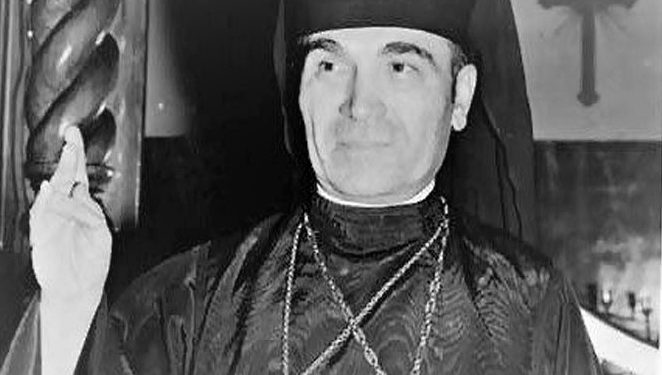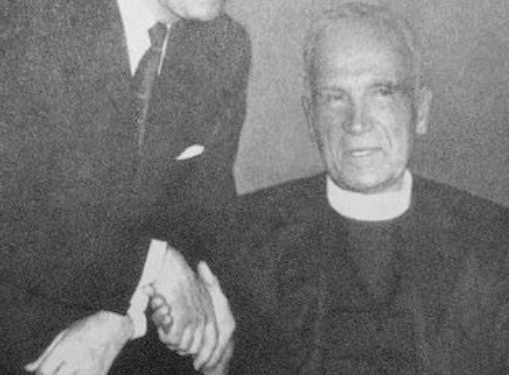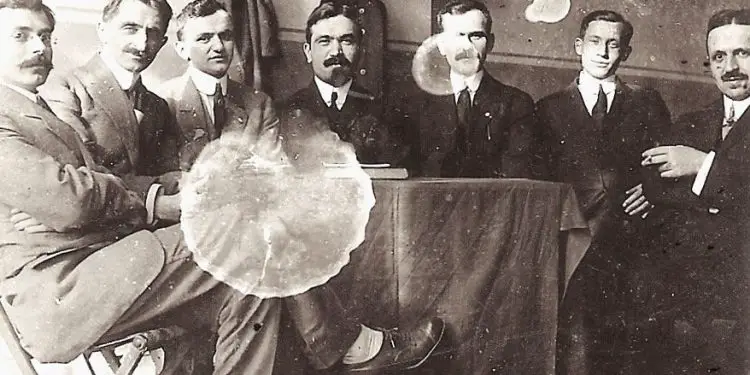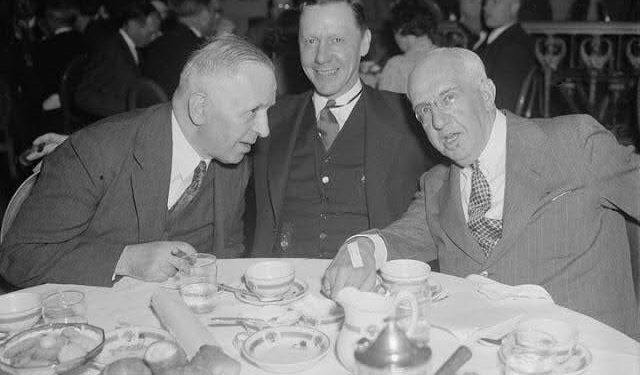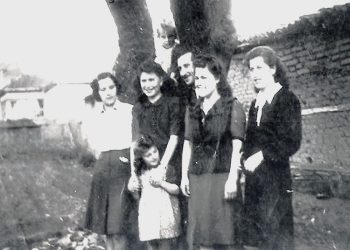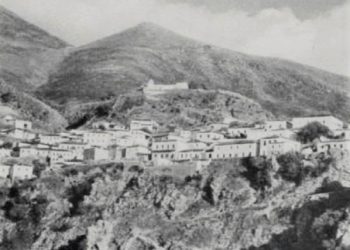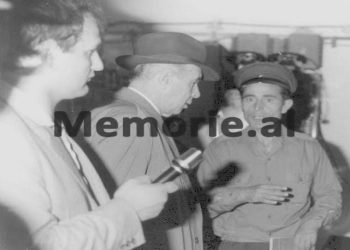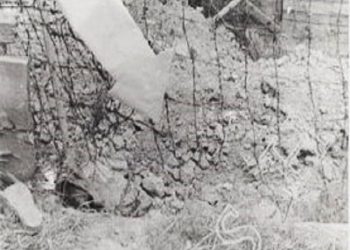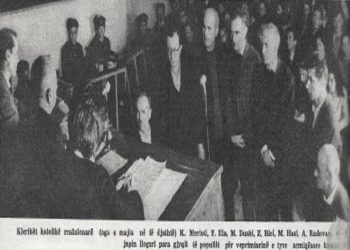By Agim Xh. Dëshnica
Part One
Memorie.al / In 1937, on the occasion of the celebrations of the 25th Anniversary of National Independence, in the official publications of the Government of King Zog, it was written: “In the sky of the Albanian cultural world shine three unfading stars, Naimi, Noli and Fishta”! In the perfect albums with unedited photographs, alongside the prominent figures of the nation, the graceful portrait of Fan S. Noli also shone. That same year, Faik Konica would say: “Father Noli will remain in the history of Albania, as the man who was the first to succeed, thanks to his will and subtlety, in speaking the Albanian language at mass. The day he celebrated mass for the first time is a white omen on the path of our progress. And we neither forget it, nor can we let others forget it.”
In 1943, Mitrush Kuteli would write: “Noli’s poetry does not have the undulation of waves in the middle of the sea, but their clashing on the side, with noise, always repeated. In the world of architecture, it does not resemble round parts, but sharp chips. Because Noli does not carve in marble, but in the seashore. He does not carve with a chisel; he cuts with an axe and a heavy hammer”. Imam Vehbi Ismaili in his 1965 lecture said: “Fan Noli became a priest, to better serve Albania. Fan S. Noli was the light, he was the eye of all his compatriots in exile. Together with him at the head, we fought with every means to liberate and protect the land of his birth”.
While the nationalist Baba Rexhepi calls it: “The first inspirer of national feelings, the leader of all patriotic, religious and cultural movements in this blessed country; the flower of the symbol of unity and national pride both before the Albanian world and before the foreign world”. The data presented, no matter how condensed, cannot provide a complete portrait of him. In March 1944, the writer Milto Sotir Gura would write: “Whole volumes are needed to describe the work of this Titan of the National Renaissance”.
Noli and the researchers
The collection, analysis and publication of the works of Fan S. Noli is neither the merit nor the property of a certain group of intellectuals. Since the early years of the last century, Noli’s works have been successfully circulating in America and in his homeland. The newspapers “Kombi” and “Dielli” were the first to bring his creativity to light. In the anthology, “Shkrimtarët albanian”, published in 1941 in Tirana, Andon Frashëri presents some of his writings. In 1943, Mitrush Kuteli gives readers the book “Mall e Brengë”, in 1944, Lifter Dilo, “Ligëron Fan Noli”. With these very attractive works, the recognition of the work of the great “hearth” begins and its further publication by other researchers, of which we highlight some.
With Noli’s care, the “Vatra” Federation published in 1948, “Album-I”, while Qerim Panariti in 1966, “Album-II”. Nexhat Peshkëpia in New York, gave Albanian readers the book, “Noli as a poet and as a poet-translator”, Tajar Zavalani remembers him in the book, “History of Albania”. Vehbi Bala and Pirro Tako, according to the demands of the time, took on the task of dealing with Noli’s work. The first, in 1958, “Album-1948”, “Selected Poems of Noli” (1966), “The Life of Fan S. Noli” (1972) and a chapter in “History of Albanian Literature” (1984).
The second, “Fan Noli in the field of politics and journalism” (1975), “The Albanian lives, or lives and does not die” (1976) and “Chronicle of the life and activity of Fan S. Noli”. Ylli Zajmi publishes, “The life and works of Fan S. Noli” (1986). Of interest are the dignified studies of Albanian scholars in Kosovo. Many foreign scholars in Europe and America have also written about Noli’s life and work. They all agree on one definition: patriot, devoted religious, democrat, poet of freedom, writer, playwright, peerless Albanianizer, statesman, orator, historian, philosopher, musicologist, composer, etc.
Mitrush Kuteli and the “Nolist” professors!
In his masterful analysis of Noli’s work in 1943, Mitrush Kuteli dreamed: “And now, in the end, the question that weighs on our souls is this: Will we have the fortune to continue and complete this panoramic view of Fan S. Noli’s poetic work? In these, today’s ups and downs, no one can know. And if fate refuses us this grace, those who come after us – they come strong – let them continue it”.
And how could our distinguished prose writer know that after him would come the “strong”, the “professors”, who would try, like many others, to erase him from the pages of history. Those who, due to their ignorance of theology, confuse the Galilee of Palestine with the Galileo Galilei of Italy. Those who draw conclusions that Noli is so-and-so: “As a patriot, artist and scholar, he grew up in the bosom of the anti-feudal and anti-imperialist movement”.
After forgetting what they said above, they continue: “Some negative aspects in his multifaceted activity and creativity stem from the limitations and pressure of the ruling bourgeois ideology, or from the flaws of his subjective character…”! Those who fabricate mysterious letters and confuse the Parliament of the 1930s with the Assembly of the 1920s. Those who weave stories about unnamed American officials of the “State Department in Boston” …(?!).
Those who have problems with knowing Noli’s languages, expect the departure of some scholar from life to represent their works. With the exception of “Volume-4”, we find ourselves facing a frightening cultural massacre. In the introductions and prefaces from beginning to end, we see only political treatments. Instead of the patriot, the Marxist, Leninist and anti-Zogist are insistently sought. Instead of the poet, the “socialist revolutionary” is sought. The religious-philosopher writes and acts “without” religious conviction.
According to the professors, Noli has created “little poetry”. The Albanianization of the poem “Gjergj Kastrioti Skënderbe” is “substandard”. In the poem “Thomson and Kuçedra”, he “boasts” the figure of a Dutch colonel, Thomson, brought to our country to organize the gendarmerie of the reactionary government of Durrës, in the service of the imperialist powers. The last poems, “The Cabinet and the Sultan” and “The Death of the Sultan”, “poems without pretensions”. But the poems of the Album such as “Hymni i Flamurit”, “Thomson and Kuçedra”, “Shpella e Dragobisë”, “Syrgjyn Vdekur”, “Anës Lumejve”, “Maratonomaku”, are equivalent to thousands of poems.
At a time when the relations of Vatra with the communist government were finally broken, “Album”-1948 takes on the appearance of the National Manifesto. Starting from the Hymn of the Flag, the other poems bring to mind the victims of the nation in the special trials, the marathonomaku with the news of victory over the dictatorship. After the Raven, Anabel Lee, the poem Skanderbeg and the Rubaiyat, Hamlet and Don Quixote, are given in fragments. The fearsome Macbeth and the treacherously murdered Julius Caesar did not even appear on the stages of our theaters.
Just like Shakespeare’s major works, Noli’s masterpieces, sometimes classical, sometimes modern, sometimes popular, live today, survive tomorrow, are eternal! It took a paleontologist like Eftim Dodona to discover writings that speak the language of documents about the truth, and even try, as with fossils, to research writings hidden in the enigmatic “caves” in the archives of Harvard University.
Although Noli lived and created outside his homeland, the Albanian language, the new words he used, the fiery verse, the flowing prose he created, are examples for action for both writers and historians today. However, it was noticed that the line of Albanian translations, by Shakespeare, Cervantes, Ibsen, Ibanez, was separated from the works and his name was lost as a simple translator under the covers of anthologies, damaged by the tendentious prefaces of professors.
In the world’s bookstores, we are not seeing Noli’s masterpieces reprinted in different languages. The book “50th Anniversary of the Albanian Orthodox Church in America” continues to be published with shortcomings. This book, with its extensive dedication to prominent figures of the nation, with historical descriptions, autobiography, documents and photographs, sheds light on everything about the life of Fan Noli and the Albanian community in America.
The works on Noli’s works, from the “strong ones”, are traversed by the same axis. The introductions, prefaces and notes have the same color, the same treatment and the same goals. Such a situation is reflected in “Anthology of Albanian Aesthetic Thought 1504-1944”, published by the writer Nasho Jorgaqi in 1979, with ready-made writings by authors such as Barleti, Bardhi, Budi, Samiu, Naimi, Çajupi, etc. Fan S. Noli with the introductions, lined up alongside them, is revealed under the weight of prefaces upon prefaces. The book is without an editor, without a reviewer and without an illustrator!
Finally, on the cover of the anthology he puts his name in capital letters, thus taking on the appearance of the author. In 1994 he lists it in his books of socialist realism, such as; “Mërgata e Cyqeve”, “Poetics of the Document”, “Skenarët”, “Dueli i heshtur”, “Tana”, “Mimoza llastica”, “Tomka dhe shokët e tij” etc.
Noli and the correspondence
Professor Jorgaqi is known above all as a collector, processor and publisher of letters of all kinds. This work begins with the book “Poetics of the Document”, at a time when the communist system was in decline. The journalistic articles and letters are diverse with topics such as: “For a folk album of Karl Marx and for a folk song”, “The new literary Marx”, “Lenin friend of an Albanian publicist” (N. Ivanaj), “Gjergj Fishta, spiritual leader of the clergy”, “Thoughts and considerations of F. Noli, on the personality and historical role of comrade Enver Hoxha”, “Pre-Marxist Noli”, “Noli, on the barricades of the class war”, “Three letters of Ali Kelmendi to Fan Noli”, “Letter to an unknown Greek friend”, etc.
The description of Marx and Lenin’s values, the “considerations” for the dictator, the distortion of Noli’s life or the devaluation of Fishta, are in full accordance with the author’s current statement, who remains “faithful to himself, his convictions, ideal and nature”. Even Kelmendi’s three letters in 1938, however fragmentary, convey only honors and no “invitation” to participate “in the revolutionary fronts.”
The generous Noli sends only books and financial aid to the sick exile in Paris. The interventions before, in between, and at the end are simply fantasy, the work of left-wing reporters. A rare epistolary find is called: “Letter to an Unknown Greek Friend,” or rather, to the Invisible Greek Man. From this “letter,” with a strong dose of humor, we learn that Noli was a young man with “debts,” who “ran away” not by day but by “night.” About the time he was a teacher in Fayum, Egypt, he wrote: “There they threatened to marry me off, and I fled to the United States of America in New York! The Statue of Liberty! Full of dollars! Long live!”
There he became a priest, not for religious or patriotic purposes, but simply for narrow personal needs, “to the city of Boston, Athens, USA.” So the professor convinces us: “From what he writes, it is clear that he had no internal motivation or conviction.” After evaluating this ugly letter, in the footnote he explains: “Compared to the Autobiography, the letter provides more accurate information about Noli’s turbulent life at this time” (!?).
Then he adds: “We do not recognize the letter in the original copy. We took it from the Greek newspaper ‘Paneperitikon’ agon”. (See “Poetics of the Document”, pages 214-215). The second, broader and more sinister version of the letter, addressed to the unknown Greek friend, is reprinted in “Vepra-6”, year 1996. (See: pages 361-364.) The first with the name “Theofan Noli”, the second “Theofanis Nolis”, date June 15, 1910.
It is the time when Noli, as a great leader, holds fiery lectures in support of the Albanian insurgents in Kosovo and northern Albania. But the professor thinks differently. To fill the readers’ minds, in the labyrinth of notes, he gives 17 explanations! For such fabrications, the researcher Mërgim Korça comes to our aid, with the exploits of Baron Munchausen:
“The war was at its peak. The front line was winding and we did not know how the situation was developing. I climbed over the top of the cannon muzzle and ordered the gunner to fire…! I grabbed the cannon and flew over the front line. After studying the situation, I jumped off the cannon on which I was flying and grabbed a cannon that was coming from the enemy lines towards our positions. That’s how I returned to base”?
“The Poetics of the Document” could survive for years and years, if the author were to baptize it “The Poetics of the Lie”. The professor also uses some phrases from the letter with the mysterious Greek in the article “Journey with Fan Noli” (1994), where the unstoppable leftist treatment of events, the well-known tendentiousness, the old way of storytelling “knee-deep with the people”, lives on.
As a true fellow traveler, the author describes Noli’s journey to America: “300 people traveled with Lloyd, most of them in animal conditions…! Noli presents himself as a revolutionary…! The entire journey would be an endless ordeal, day and night in the rain and cold, amidst the shocking waves of the ocean…! But while the others remained locked in their cabins, he would go out on deck and read Nietzsche” (?!!).
Was the young Noli sailing to organize the socialist revolution in New York? He further adds: “But there comes a moment when he is shocked and touched that all these people did not know that there was a country called Albania”!
It would take the year 1913, the year of unjust decisions, for the “troubled” and tired people in the cabins to see a new state on the map of the Balkans. The writing is also built with the help of elderly housewives who cannot speak Albanian or an expatriate who happened to meet Noli by chance in a park, while reading the newspaper with news from Hungary. The author is easily understood when he tries to address his opinion on the Hungarian Uprising to our liberating poet. In conversations with old “hometown people”, he also tries in vain, contrary to the facts, to use their memories as evidence to place Noli of freedom of thought on the left wing.
The series of letters continues. We again encounter strange announcements. The author writes: “From time to time, Noli has received letters from intellectuals in the voice of Albania… M. Kuteli gives him the happy news that he has been elected Honorary Chairman of the Albanian Writers’ League and that a number of writers are following his path in the field of literature.”
We give without comment two letters that shed light on this wonder. The first, Mitrush Kuteli May 30, 1945:
“Dear Master, Mr. Stephan of the American Mission in Albania is giving me the opportunity to write you these lines. He himself, earlier, had given me the idea to send you the collection of some of Uja’s poems to which I gave the name “Mall e Brengë”,… On this occasion I am also sending you some of my books, begging your forgiveness for their poor presentation – just like our country is – as well as for other shortcomings. I can say without fear that you have created a literary school here, the influence of which is very much felt in the writings of the young. – I wish you good health and good old age. Mitrush Kuteli”.
Second, Sejfulla Malëshova December 12, 1945:
“To His Excellency Noli. For the great contribution you have made to the field of Albanian culture and literature, the Conference of Albanian Writers that met in Tirana on October 7-11, 1945, elected you Honorary President of the Albanian Writers’ League. I feel great joy that I am the one who is communicating this to you. With respect – President of the Albanian Writers’ League, Sejfulla Malëshova”.
At that time, Mitrush Kuteli was in the tragic Maliqi camp, where on the cold mornings of December 1945, he had to silently listen to the appeal in front of the camp barracks. From these fabrications, doubt naturally arises about the accuracy of other letters, and even of some lectures, when Noli was living and writing in Europe.
The long series of official letters with the Communist Government in Tirana, on important national issues during 1946, express Noli’s great concern and care for the Fatherland. At the end of that year, his anger towards the behavior of the delegates that Enver Hoxha sent for talks with strict orders is clearly felt. After the criticism and bitter news that arrived from Albania, Noli’s blessings came to an end.
In 1947, diplomatic relations were completely broken. The Patriotic Hearth would be described by the Academy of Sciences as: “a reactionary organization that came to defend the anti-Albanian policy of the American government. In 1960, the patriotic part left it and created the organization “Free Albania.” (?!).
So, another distortion, when it is known that this organization was created as an opponent of “Vatra” a long time ago. A significant document, published in the newspaper “Dielli”, January-March 2003, sheds light on this.
Furthermore, the letters to Milto Sotir Gura, published by Professor Jorgaqi in 1996, were used to convince the Albanian people how “happy” they were living under terror. Could Noli, after the shocking news from Albania, endanger his friends with postal letters? How could he complain about his situation in America, at the peak of progress? Memorie.al
To be continued in the next issue




